Hi there! Our site collects data and uses cookies to analyze traffic and for ad measurement purposes. Is that OK with you? We're a small business and doing this helps us a lot.
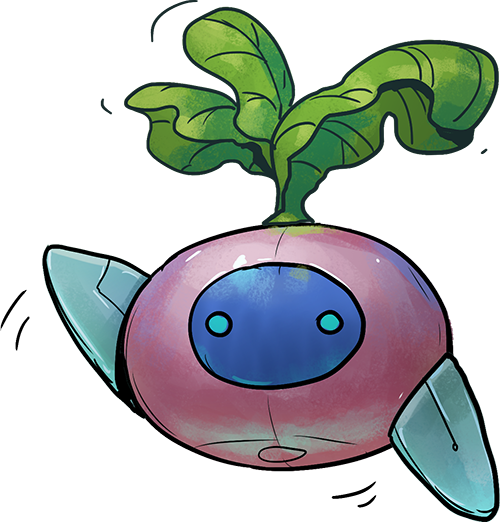
Hello, hello!
Zip here to help you out!
Before we zip ahead of ourselves, make sure that you already put the jigsaw puzzle together. Oh, you did? That's great!
Your assembled jigsaw should look like this, with the music notes in the center. Does it?
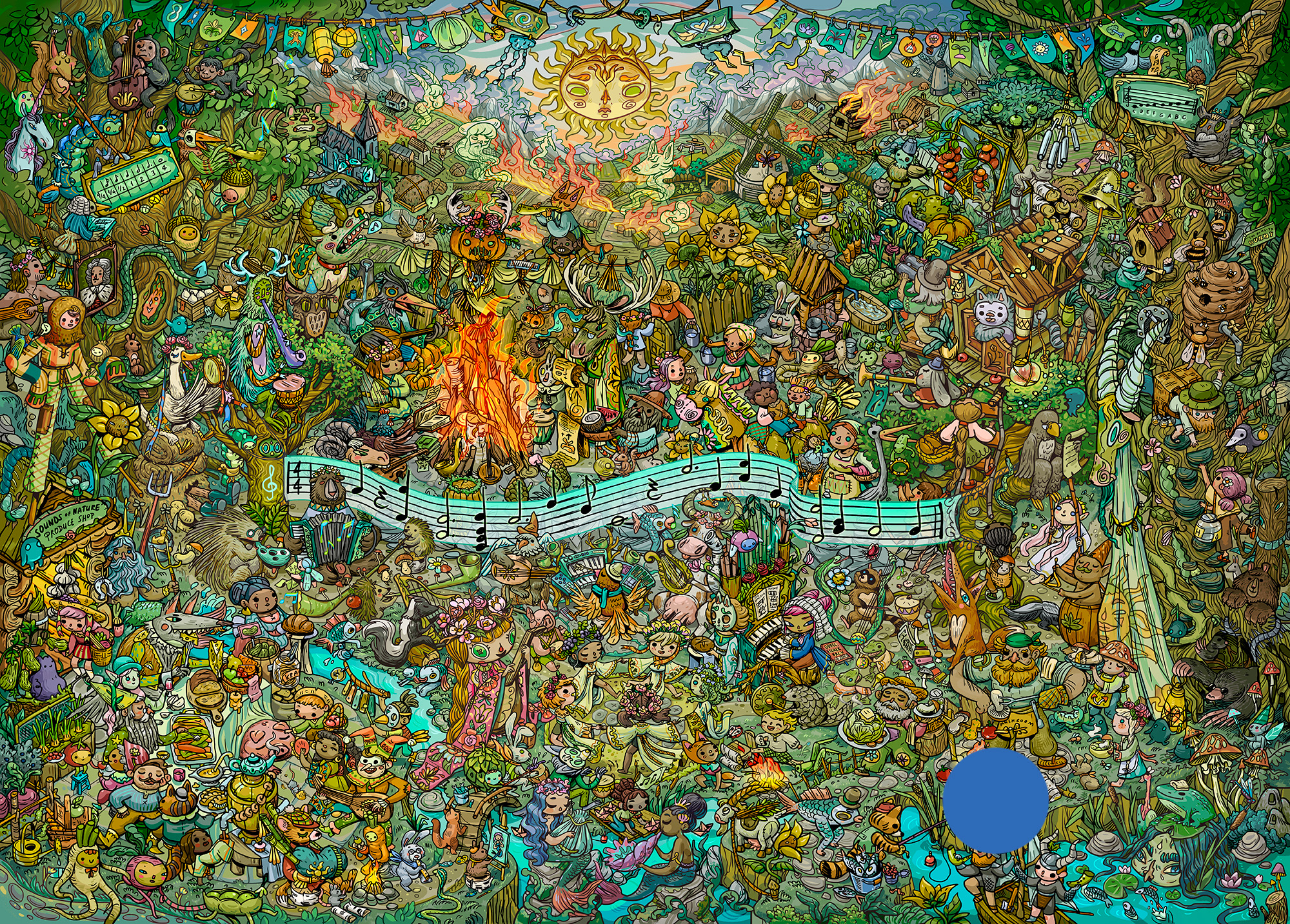
Oh dear, that's embarrassing. This might mean you got a misprinted copy. Sorry about that! Please reach out to us and we'll make it right. In the meantime, if you want to continue solving, please print this image and use that to continue on.
So then I bet you either need hints, or you already decoded Riley's message and want to check your answer. I sure hope it's that last one!
Oh my, I am so excited to see what you came up with. To check your answer, type it into the box below and hit the button. If you are wrong, I will let you down gently without giving away the correct answer.
Oh dear, I am so sorry, that is not right. Keep at it and I just know you will get there eventually.
That is so, so close! Can you split that up into three words? Note the quarter rests, which you could say are like brief pauses in music.
Holy moly, that is correct! You did it! Hooray for you! Let's patch Riley in here to give you the full rundown.
You seem to be having a little trouble decoding Riley's message. If you want me to patch Riley in to tell you the answer and explain the whole thing, just let me know.
Roger that! Whenever you need a nudge along, just click a hint below.
- Oh my, I do hope Riley’s special tune helps. That fire is getting close. Everyone is familiarizing themselves with the notes she wrote on that banner in the middle. Maybe you should take a look once more, too... Oh my, I do hope Riley’s special tune helps. That fire is getting close. Everyone is familiarizing themselves with the notes she wrote on that banner in the middle. Maybe you should take a look once more, too...
- Riley carefully crafted that tune to translate to a three-word phrase. If you lack the talent of Johann Sebastian Bach, our caterpillar and owl friends have you covered with their signs at top left and top right. And if that is not enough, our internet friend should have you covered too—look up whatever you need to online. Riley carefully crafted that tune to translate to a three-word phrase. If you lack the talent of Johann Sebastian Bach, our caterpillar and owl friends have you covered with their signs at top left and top right. And if that is not enough, our internet friend should have you covered too—look up whatever you need to online.
- Oh, I told Riley this could get complicated. But your crash course in musical notation can be simple. Just take note of which notes represent which letters, how many beats each type of note gets, and what things like chords and rests are. Oh, I told Riley this could get complicated. But your crash course in musical notation can be simple. Just take note of which notes represent which letters, how many beats each type of note gets, and what things like chords and rests are.
- I would not actually try to play Riley’s tune if I were you. You don’t want the rain gods sending a monsoon your way. Besides, it was written to appeal more to Mother Nature. What did the caterpillar’s sign say before in the reference image? I would not actually try to play Riley’s tune if I were you. You don’t want the rain gods sending a monsoon your way. Besides, it was written to appeal more to Mother Nature. What did the caterpillar’s sign say before in the reference image?
- I believe it said, “Music is math and math is music.” Is that helpful? To be fair, everything is math to me. I believe it said, “Music is math and math is music.” Is that helpful? To be fair, everything is math to me.
- Don’t forget! Riley loves to think of letters and numbers as one and the same. Don’t forget! Riley loves to think of letters and numbers as one and the same.
- Chords are two or more notes played at the same time. I suppose you could say they get added together. Chords are two or more notes played at the same time. I suppose you could say they get added together.
- The number of beats a note or chord gets determines how long it is played for. Perhaps you could say it multiplies the note’s duration. The number of beats a note or chord gets determines how long it is played for. Perhaps you could say it multiplies the note’s duration.
- Rests are brief pauses in music. Like spaces between words. Rests are brief pauses in music. Like spaces between words.
- Oh dear, there’s no more time to be coy. Let me be more direct: add the alphanumeric values of the notes in each chord together, then multiply by the number of beats that chord gets. Oh dear, there’s no more time to be coy. Let me be more direct: add the alphanumeric values of the notes in each chord together, then multiply by the number of beats that chord gets.
- I sense that an example may help. That first note on the banner is an A. It is also a quarter note, so it gets 1 beat. The letter A is the first letter of the alphabet, so you can think of it as the number 1. So, A x 1 beat = 1 x 1 = 1 = A, the first letter in Riley’s message. I sense that an example may help. That first note on the banner is an A. It is also a quarter note, so it gets 1 beat. The letter A is the first letter of the alphabet, so you can think of it as the number 1. So, A x 1 beat = 1 x 1 = 1 = A, the first letter in Riley’s message.
- That second note on the banner is a chord, composed of an F and a G. Both are quarter notes so they each get 1 beat. So, (F + G) x 1 beat = (6 + 7) x 1 = 13 = M. That second note on the banner is a chord, composed of an F and a G. Both are quarter notes so they each get 1 beat. So, (F + G) x 1 beat = (6 + 7) x 1 = 13 = M.
- The third note is a dotted half note (3 beats) made up of an E and a B. So this time it results in (E + B) x 3 beats = (5 + 2) x 3 = 7 x 3 = 21 = U. Keep going! The third note is a dotted half note (3 beats) made up of an E and a B. So this time it results in (E + B) x 3 beats = (5 + 2) x 3 = 7 x 3 = 21 = U. Keep going!
- Do you get it? Riley’s message is not too unlike that sacrificial bonfire the critters have going. Oh, she is a clever one. Do you get it? Riley’s message is not too unlike that sacrificial bonfire the critters have going. Oh, she is a clever one.
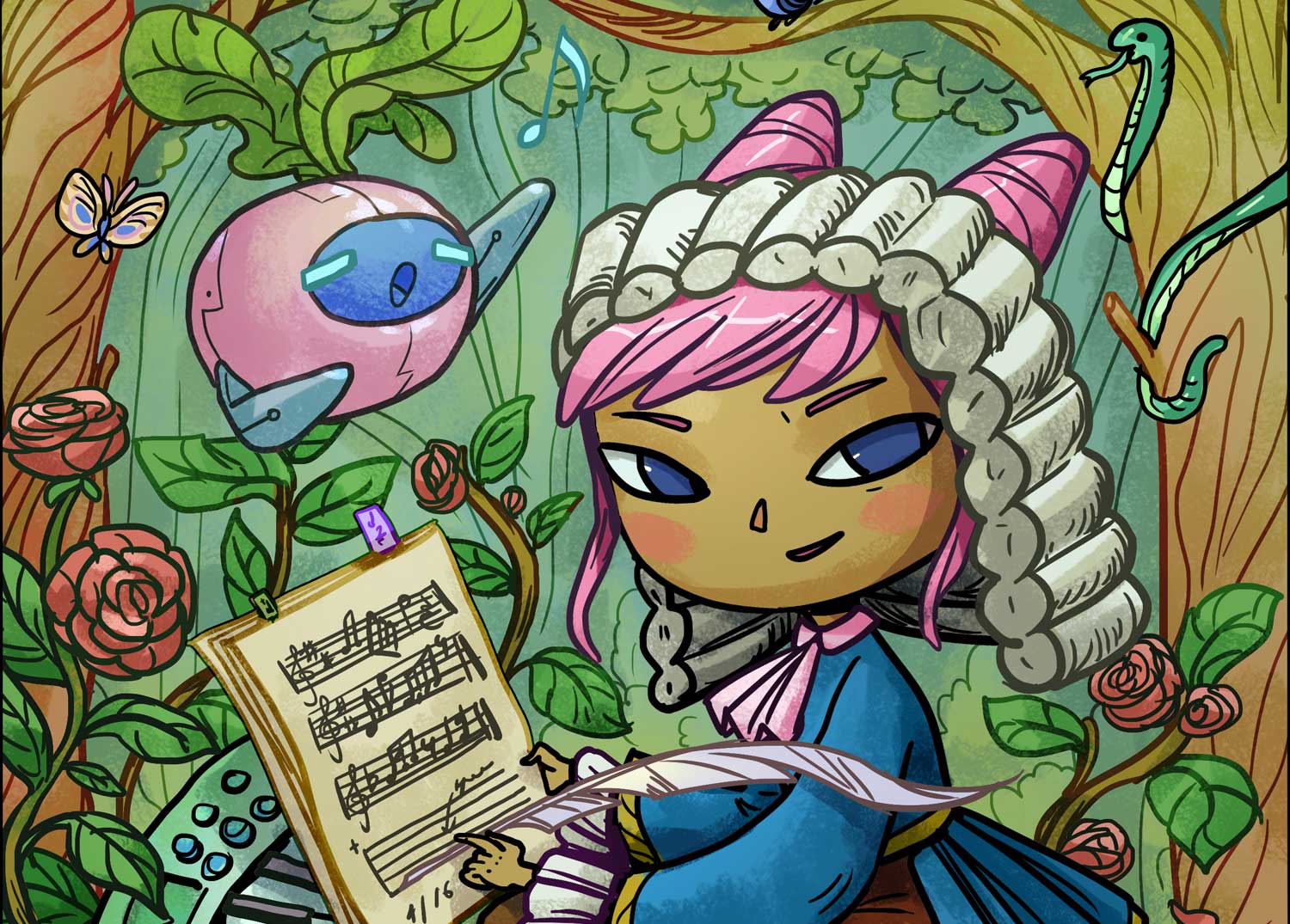
Well huzzah and hallelujah, our festival worked once again!
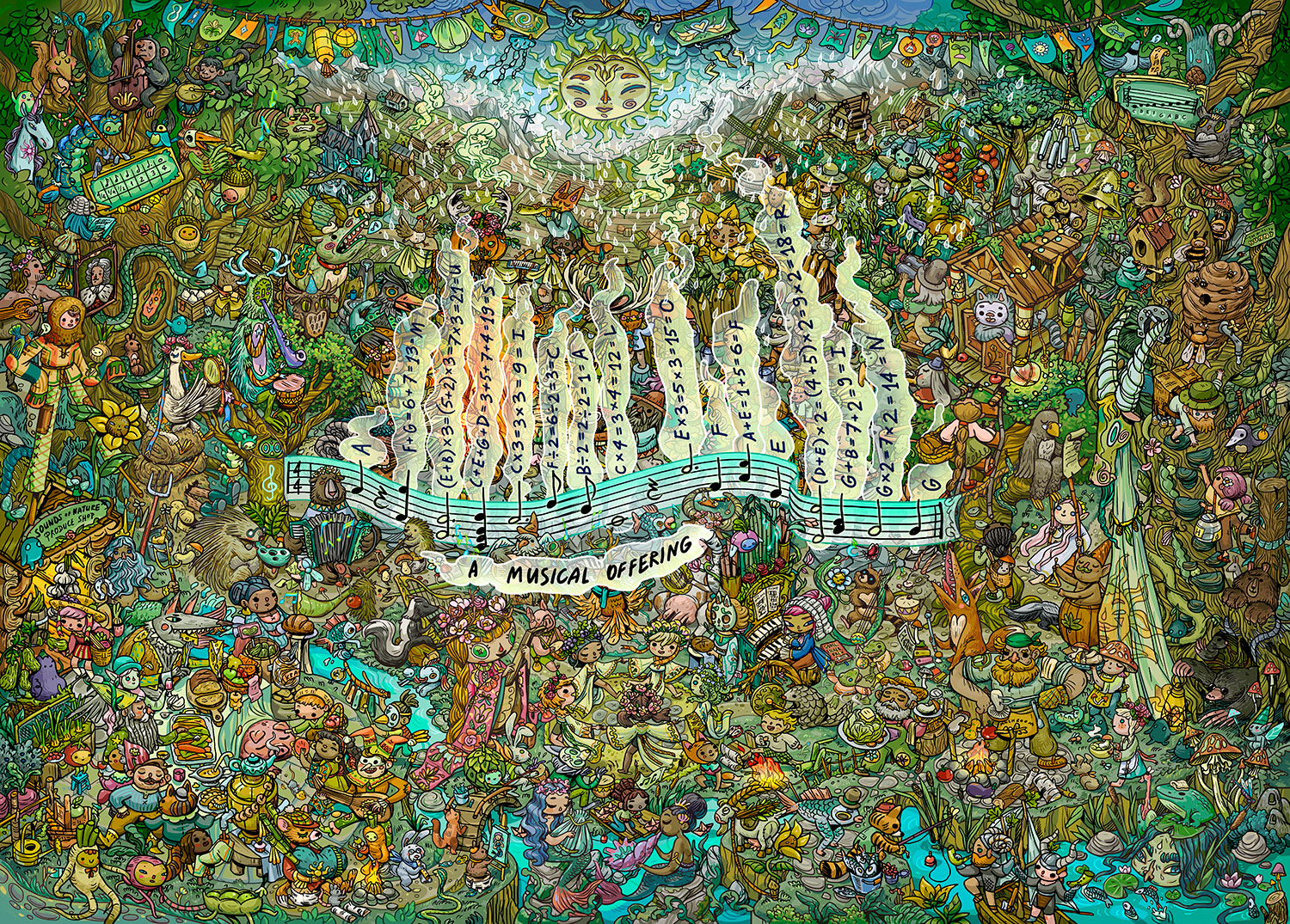

(hover over the image to zoom)
(pinch to zoom)
Mother Earth heard our “musical offering” and the rain gods sure doused the heck out of that wildfire. It’s like a monsoon up in here!
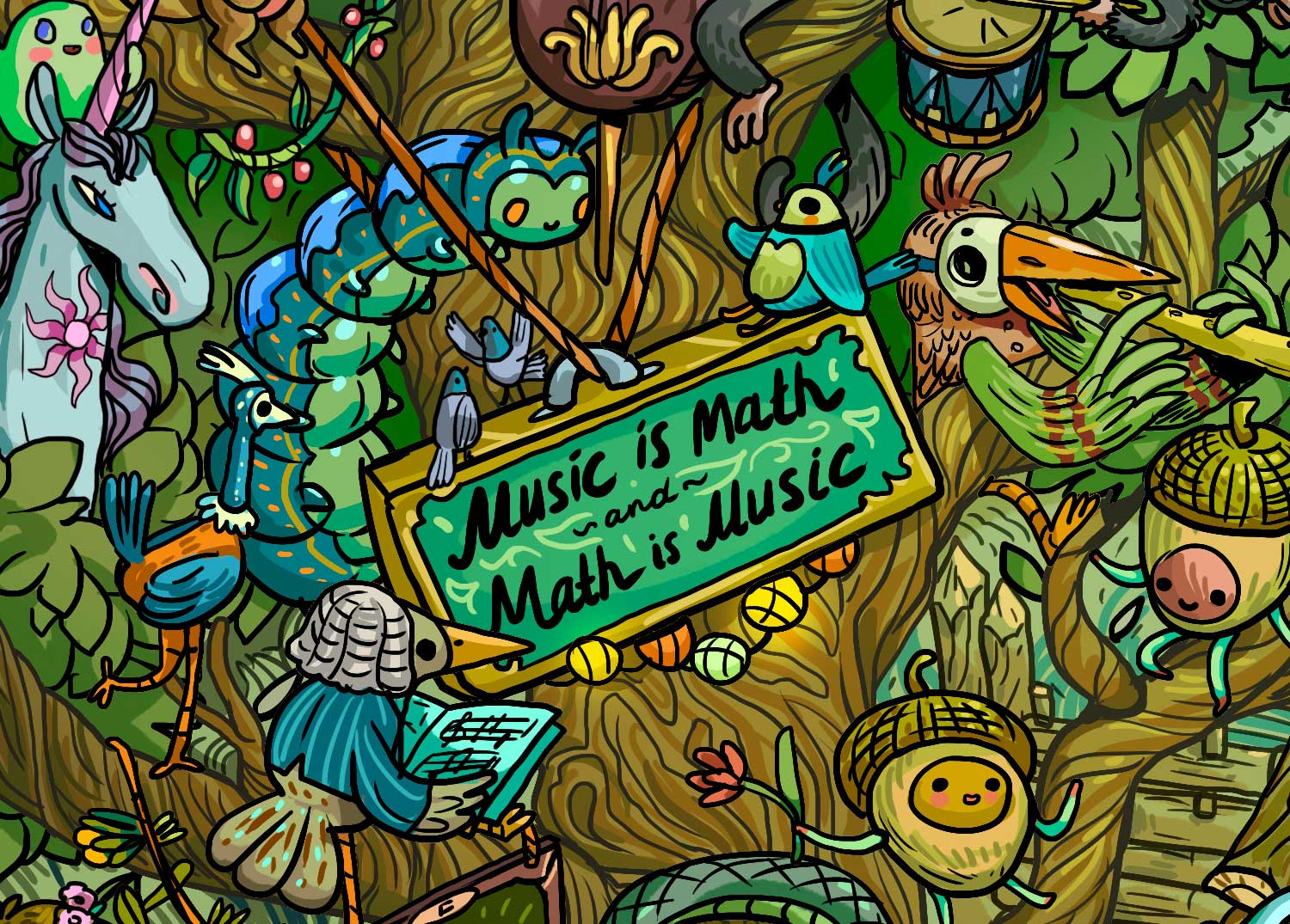
See, when my caterpillar buddy was holding up that sign saying “music is math,” I was hoping that would remind you of all the mathematics that go into creating sensational harmonies (in both music and nature). And of course that you might be reminded that I just love turning letters into numbers and back again. It’s kinda my thing.
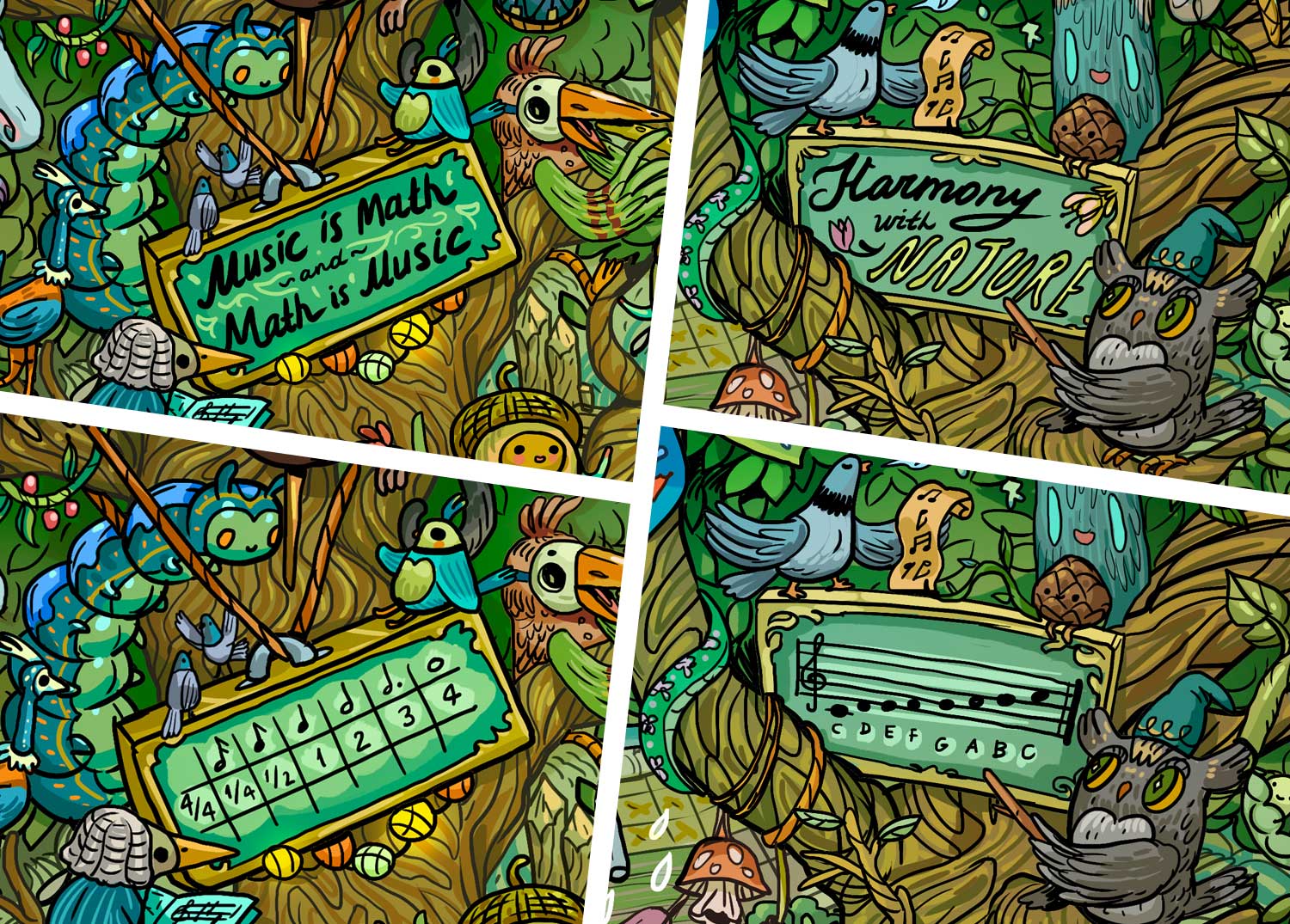
To figure this one out, you gotta know how to read music. If you’re not already an expert banjo or ocarina player like my furry pals here, the caterpillar and owl have you covered with their signs showcasing some music fast-facts. But you could also check out a quick tutorial online. Props to you for jumpstarting your music career!
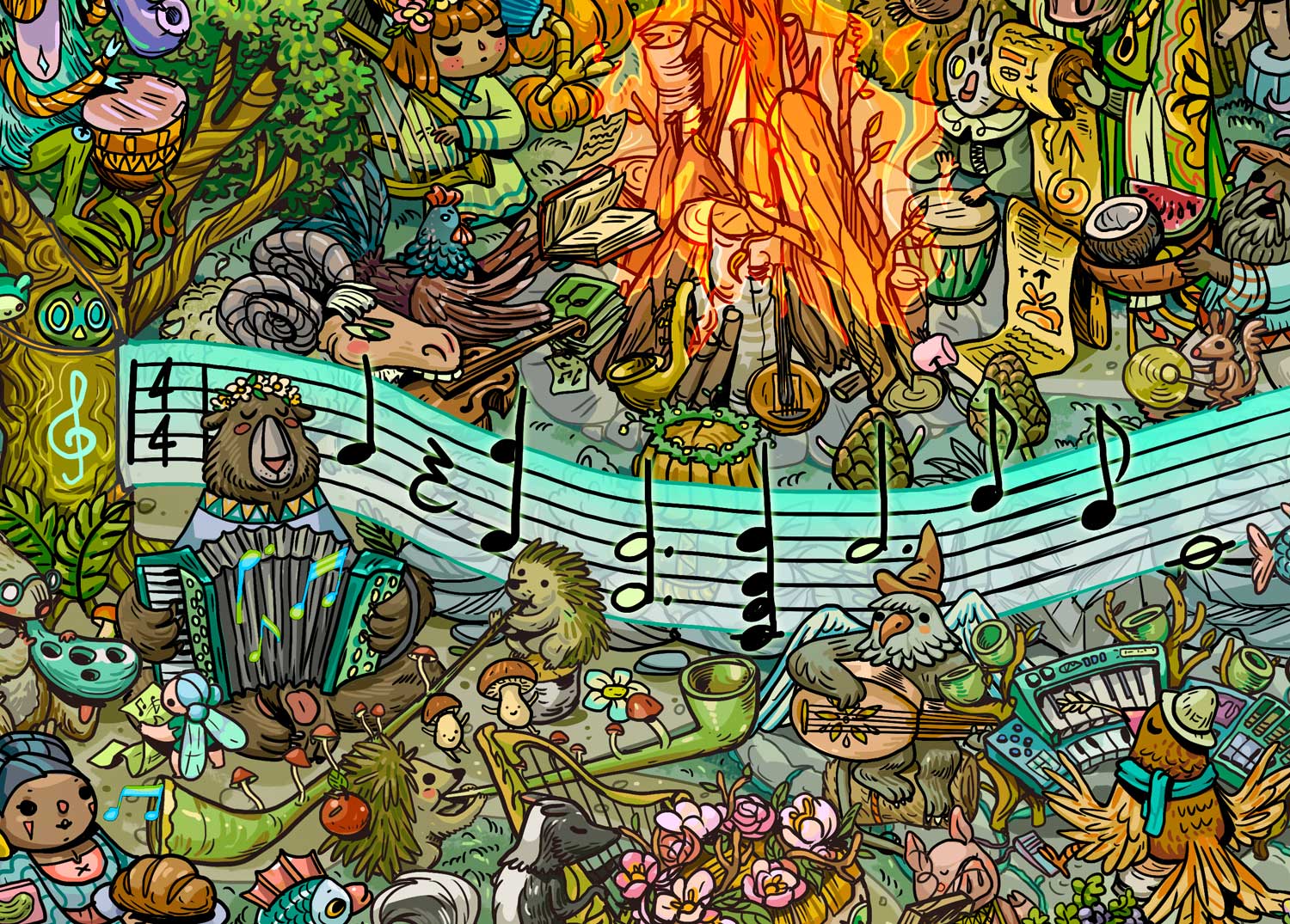
Here’s a primer: each dot (called a “note”) drawn on those lines of music (called a “staff”) represents a letter A through G. Solid circles with a straight tail (quarter notes) are notes held for one beat of music. Solid circles with a flagged tail (eighth notes) are held for half a beat. Empty circles with a straight tail (half notes) are held for two. Empty circles with a straight tail and a dot next to them (dotted half notes) are held for three beats. And empty circles with no tails (whole notes) are held for four. Those little squiggles in between mean you rest for one beat, and when multiple notes stack on top of each other, they’re played together as a “chord”.
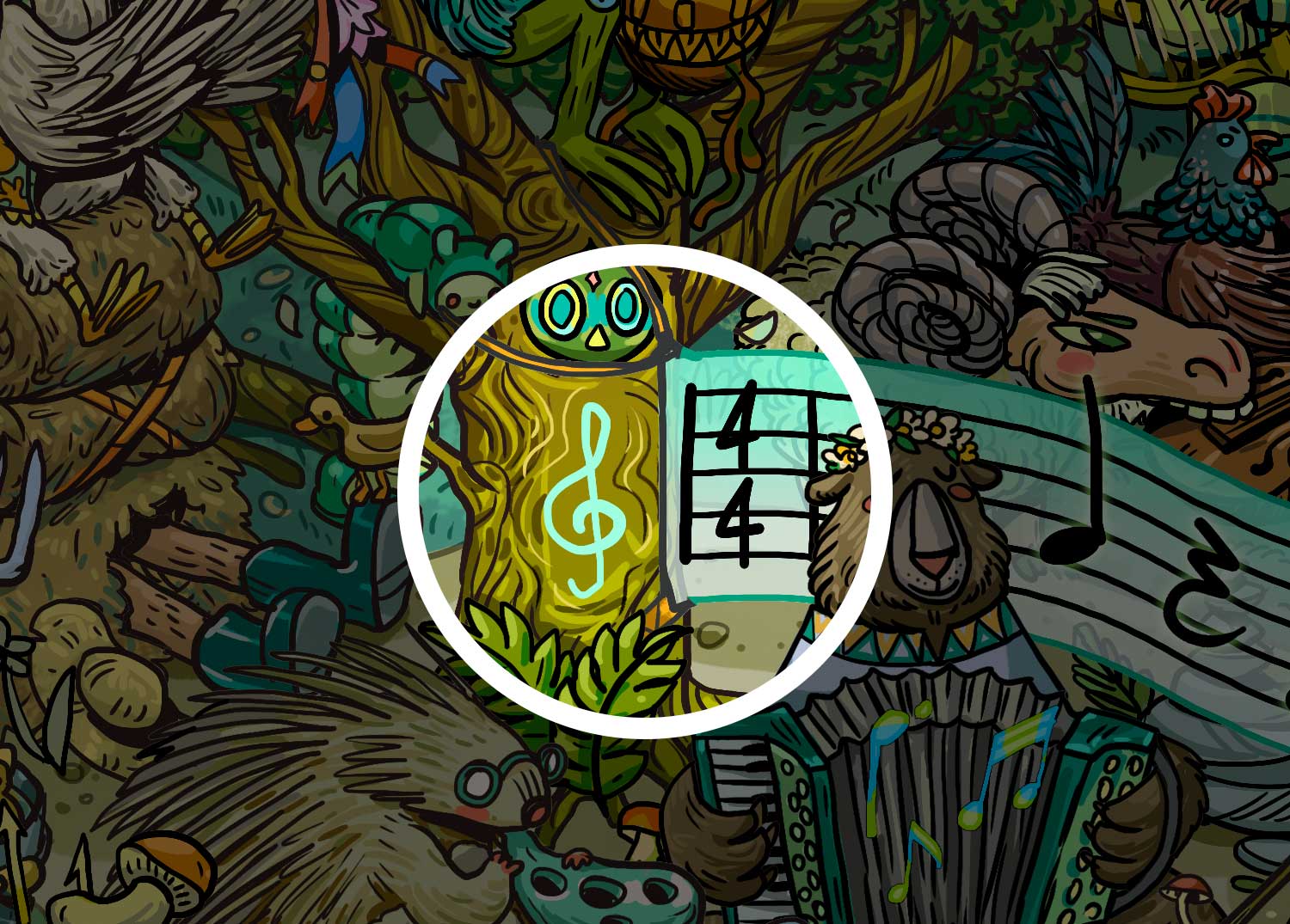
For you Mozarts out there, note that we’re only dealing with the treble clef and 4/4 time as indicated on my banner. That’s why the notes are what they are and why they get those many beats. But if you don’t know what all this means, don’t worry! The treble clef and 4/4 time is the most common thing anyway, so that’s probably what you already stumbled upon if you turned to the internet for help.
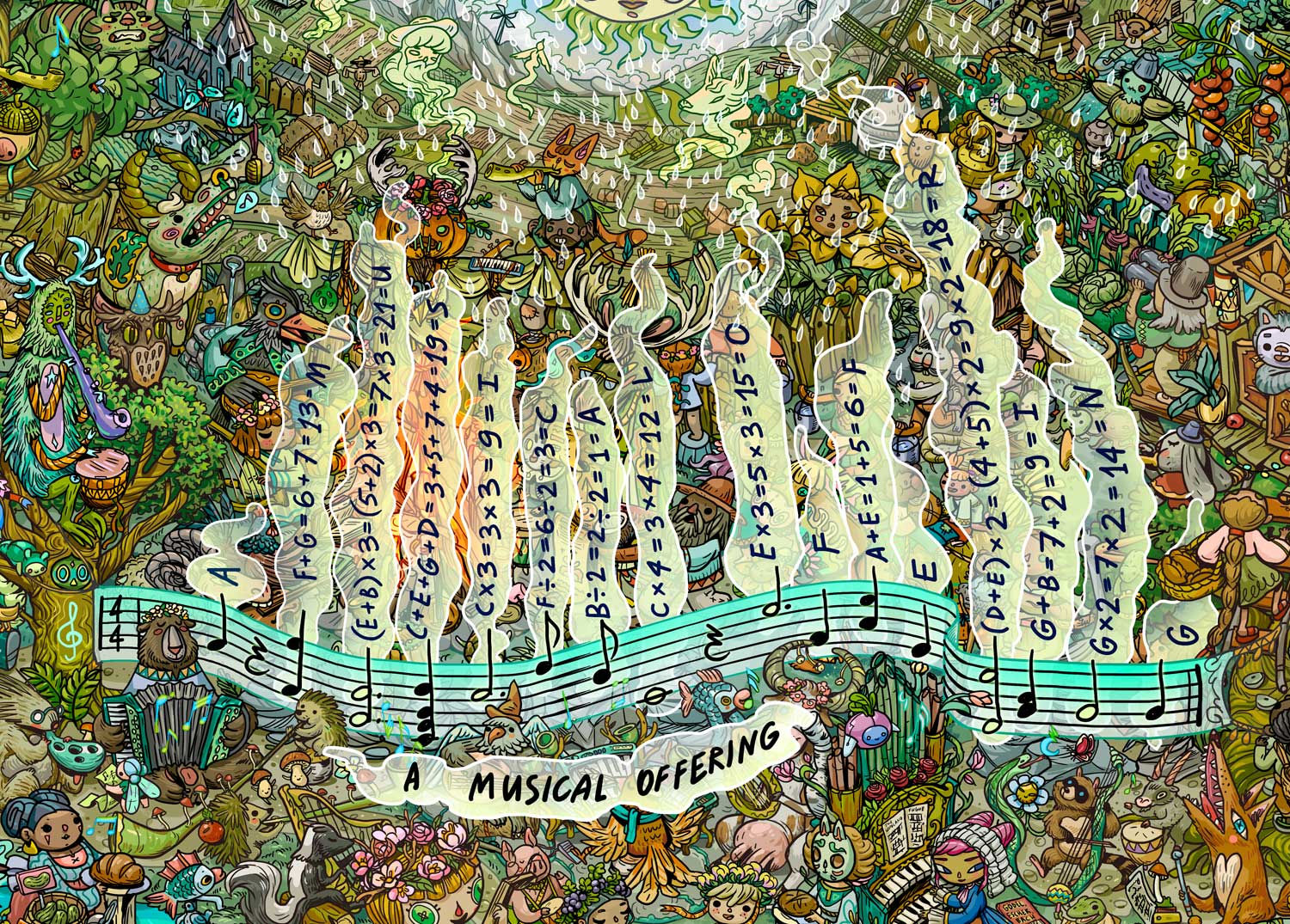

(hover over the image to zoom)
(pinch to zoom)
Okay, musical notation lesson over. Let’s get into the math. Since chords are notes played at the same time, it’s almost like those notes get
added
together. And the number of beats you hold the note for is almost like a
multiplier,
right? And couldn’t the pause afforded by a rest be thought of like a
space
between words? Hmm??
Right, so, getting into the nitty gritty...
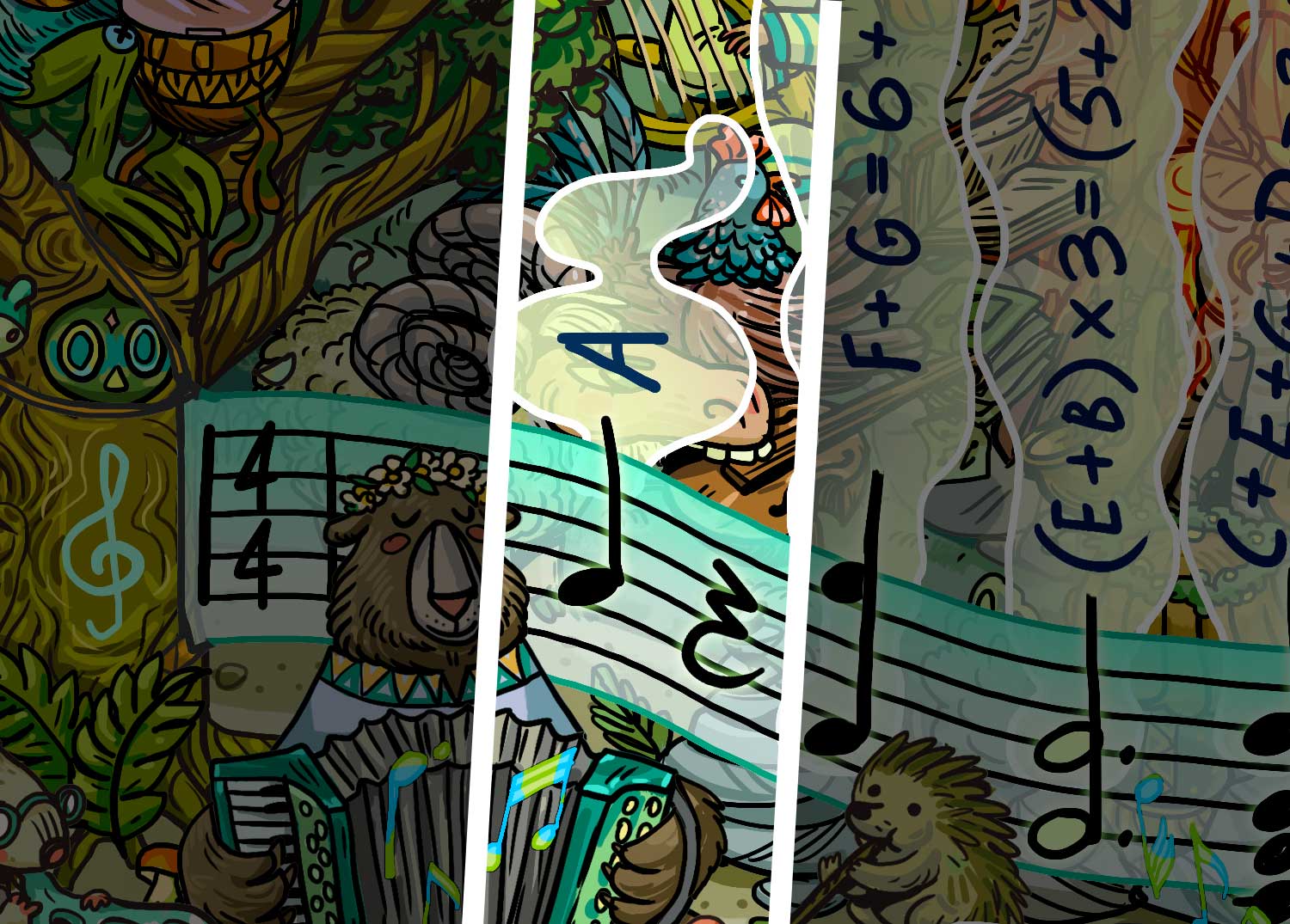

(hover over the image to zoom)
(pinch to zoom)
That first note on the banner is an A. It’s also a quarter note, so it gets 1 beat. The letter A is the first letter of the alphabet, so you can think of it as the number 1. So, A x 1 beat = 1 x 1 = 1 = A, the first letter in my message.
Then there’s a rest, which translates to a space. So A is your first word. Easy peasy!
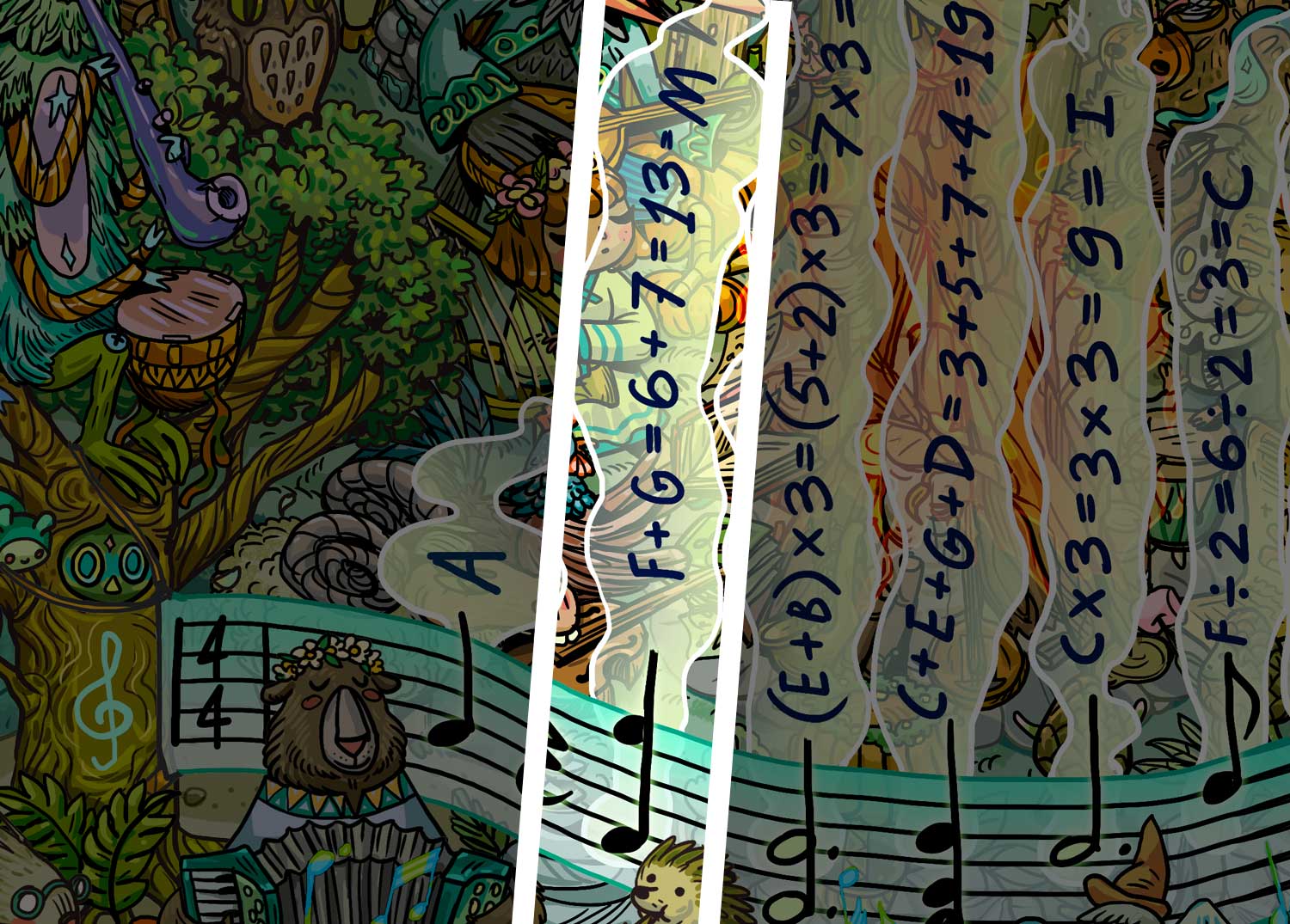

(hover over the image to zoom)
(pinch to zoom)
That second note on the banner is a chord, composed of an F and a G. A little dissonant when played, but it worked for us! Both are quarter notes so they each get 1 beat. So, (F + G) x 1 beat = (6 + 7) x 1 = 13 = M.
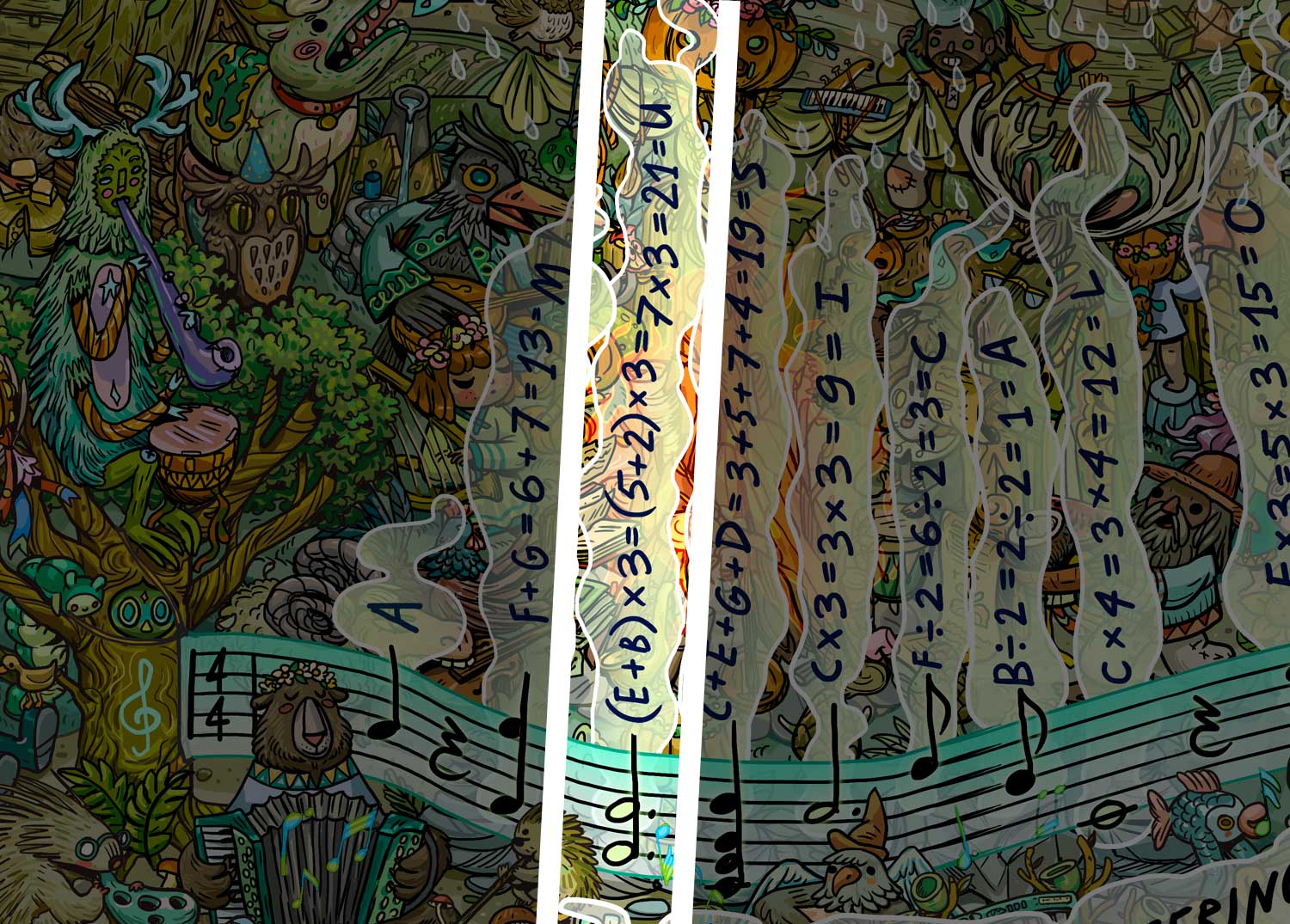

(hover over the image to zoom)
(pinch to zoom)
The third note is a dotted half note (3 beats) made up of an E and a B. So this time we’ve got (E + B) x 3 beats = (5 + 2) x 3 = 7 x 3 = 21 = U.


(hover over the image to zoom)
(pinch to zoom)
Details on the rest of the notes are in the photo above. Keep in mind that for eighth notes, which get half a beat, you multiply by ½, otherwise known as dividing by 2.
In the end, you see that my tune spells out “A MUSICAL OFFERING.” Like the moose’s sacrificial bonfire and our woodland soiree at large, our little concerto is a humble gift—an offering, if you will—up to the nature gods to help us stop those wildfires.

Of course it’s also a nod to my favorite composer of all time and the dude I’m currently cosplaying: Johann Sebastian Bach. Back in the day, he wrote some “riddle fugues” he called the Musical Offering to honor King Frederick the Great. Kind of how I made this musical riddle for us to honor Mother Earth.